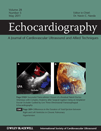Journal list menu
Export Citations
Download PDFs
Original Investigations
On-Orbit Prospective Echocardiography on International Space Station Crew
- Pages: 491-501
- First Published: 29 April 2011
Cardiac Toxicity Screening by Echocardiography in Healthy Volunteers: A Study of the Effects of Diurnal Variation and Use of a Core Laboratory on the Reproducibility of Left Ventricular Function Measurement
- Pages: 502-507
- First Published: 29 April 2011
CME
Differences in the Duration of Total Ejection between Right and Left Ventricles in Chronic Pulmonary Hypertension
- Pages: 509-515
- First Published: 04 May 2011
Effect of Position Changes on Myocardial Velocity in Healthy Subjects Evaluated by Tissue Doppler Echocardiography
- Pages: 516-519
- First Published: 29 April 2011
A Quantitative Analysis of Left Ventricular Filling Pressures in Patients with a Reduced Ejection Fraction, with or without Concomitant Left Bundle Branch Block
- Pages: 520-529
- First Published: 04 May 2011
Metabolic Syndrome Impacts the Right Ventricle: True or False?
- Pages: 530-538
- First Published: 29 April 2011
Comparison of Two Different Speckle Tracking Software Systems: Does the Method Matter?
- Pages: 539-547
- First Published: 24 April 2011
Speckle Tracking Imaging in Acute Inflammatory Pericardial Diseases
- Pages: 548-555
- First Published: 04 May 2011
The Advantage of Global Strain Compared to Left Ventricular Ejection Fraction to Predict Outcome after Acute Myocardial Infarction
- Pages: 556-563
- First Published: 29 April 2011
Early Detection of Silent Ischemia and Diastolic Dysfunction in Asymptomatic Young Hypertensive Patients
- Pages: 564-569
- First Published: 23 March 2011
Coronary Flow Reserve, Strain and Strain Rate Imaging during Pharmacological Stress before and after Percutaneous Coronary Intervention: Comparison and Correlation
- Pages: 570-574
- First Published: 04 May 2011
Contrast Echocardiography Improves Interobserver Agreement for Wall Motion Score Index and Correlation with Ejection Fraction
- Pages: 575-581
- First Published: 29 April 2011
Review
Intracardiac Echocardiography: Clinical Utility and Application
- Pages: 582-590
- First Published: 12 May 2011
Case Reports
Online only
Left Atrial Appendage Lipoma: An Unusual Location of Cardiac Lipomas
- Pages: E91-E93
- First Published: 17 February 2011
Cardiac lipomas are benign rare neoplasms of the heart. They are encapsulated and well defined subendocardial or subepicardial masses that can be seen at the atrial or ventricular level. Unlike cardiac thrombus and other tumors, lipomas have low tendency to develop peripheral emboli. Although transesophageal echocardiogram (TEE) is the procedure of choice to evaluate for atrial thrombus and masses, it might be difficult to conclude a diagnosis especially in the left atrial appendage. Cardiac imaging is essential to differentiate left atrial appendage lipomas (LAAL) from other tumors and thrombi to avoid unnecessary intervention. We report the first case of LAAL found incidentally by intraoperative TEE.
Anomalous Left Superior Pulmonary Venous Connection with Intact Interatrial Septum
- Pages: E94-E96
- First Published: 23 February 2011
Partial anomalous pulmonary venous connection (PAPVC) with intact interatrial septum is an uncommon congenital anomaly, while isolated left pulmonary venous connection with intact interatrial septum is rare. In this report, a 5-year-old girl with chief complains of mild short breath after exercise was diagnosed of anomalous connection between left superior pulmonary vein (LSPV) and left innominate vein by transthoracic echocardiography (TTE) that was confirmed by 3D cardiac CT scanning.
Isolated Congenital Left-Sided Pulmonary Vein Stenosis in an Adult Patient Misdiagnosed as Primary Pulmonary Hypertension
- Pages: E97-E100
- First Published: 23 February 2011
Isolated Pulmonary vein stenosis (PVS) in adults is a rare condition, especially in absence of associated congenital heart disease. We report PVS of left sided pulmonary veins in an 18 year old male, who until then had been mistakenly diagnosed as primary pulmonary hypertension (PPH). The case highlights the fact that evaluation for pulmonary vein stenosis is essential for all patients with severe unexplained pulmonary.
Successful Transcatheter Closure of a Residual Patent Ductus Arteriosus with Complex Anatomy after Surgical Ligation Using an Amplatzer Ductal Occluder Guided by Live Three-Dimensional Transesophageal Echocardiography
- Pages: E101-E103
- First Published: 14 March 2011
Residual patent ductus arteriosus (PDA) after surgical ligation is not common and it may be distorted by the surgery resulting in a difficult transcatheter closure. Such distorted anatomy of the duct may not be demonstrated by the two-dimensional transesophageal echocardiography (2D TEE), but live 3D TEE provided the precise anatomy of the elongated distorted residual duct. In the case presented herein, live 3D TEE provided novel images of complex residual duct and successful guidance of the Amplatzer ductal occluder (ADO) deployment.
Research from the University of Alabama at Birmingham
Transesophageal Echocardiographic Detection of Thrombus Superimposed on Metastatic Left Atrial Tumor
- Pages: 591-592
- First Published: 05 May 2011
Image Section
Online only
Collar Bone Left Atrium
- Pages: E104-E105
- First Published: 23 March 2011
We present a 63-year-old man who presented with chest discomfort and breathlessness on exertion. Echocardiography revealed a D'Cruz Type II left atrial compression by giant descending thoracic aortic aneurysm. The echocardiographic assessment of this condition is highlighted.
Incremental Benefit of 3D Transesophageal Echocardiography: A Case of a Mass Overlying a Prosthetic Mitral Valve
- Pages: E106-E107
- First Published: 23 March 2011
A young woman with a mechanical mitral prosthetic stenosis underwent multiple imaging modalities including fluoroscopy, two-dimensional transthoracic and transesophageal echocardiography and real time three-dimensional transesopahgeal echocardiography (3D TEE) to determine the cause of her stenosis. Only 3D TEE demonstrated the full size and extent of an obstructing mass on the strut and sewing ring of the prosthetic mitral valve.
Echo Rounds
Risk of Low-Level Ionizing Radiation from Medical Imaging Procedures
- Pages: 593-595
- First Published: 29 April 2011




